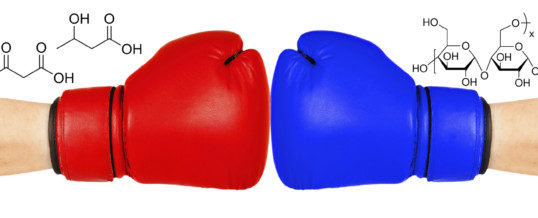To Ketone or to Glucose? That is the Question.
by Emily Zacherle.
How do you fuel your body: ketones or glucose? That seems to be a highly debated question in the fitness world and has been for many years. In particular and probably more familiar to most is the ketogenic diet. You know, the high fat, very low carbohydrate diet held in high regard by some and frowned upon by others. Wrestlers, Olympic lifters, powerlifters, bodybuilders and even your standard gym goers have all used this diet to drop weight quickly without major losses in performance. But what’s behind this diet and what does it actually mean in terms of energy production and exercise capacity?
Before we dive right into ketosis, let’s first talk about our ‘normal’ fuel driven state. The human body is a glucose controlled machine. Carbohydrates are ingested, primarily broken down into glucose in the gastrointestinal tract, and transported through the bloodstream to various cells within the body to be used as energy or stored as glycogen within the skeletal muscle and liver. Traditionally, 40-55% of our energy is derived from carbohydrates. When in its simplest form (monosaccharide) as glucose or dextrose, carbohydrates are absorbed and utilized for energy rapidly. Although, when we ingest foods, carbohydrates are in a more complex form (polysaccharides) and require additional steps for breakdown and energy use.
So why do we need glucose? The brain is actually the most prominent consumer of glucose but has no method by which to store it (unlike skeletal muscle), so glucose is taken from the blood or liver. In stressful situations, such as taking a challenging test, the brain preferentially utilizes up to 90 percent of available glucose to meet its energy needs. Skeletal muscle is actually the brain’s top competitor in terms of glucose use, particularly during physical exertion. No surprise, right? Although, depending on the exercise (intensity) of choice, skeletal muscle will also utilize fatty acids or amino acids for energy production. Since amino acids aren’t a primary source of fuel, we won’t talk about them here. Regardless of fuel source, adenosine triphosphate (ATP) is the energy storing molecule required for and produced by aerobic and anaerobic pathways of energy production. So how exactly does the body choose between glucose and fats? From a high level, it really comes down to exercise intensity and nutrient availability.
During intense, short term workouts (~10 seconds), ATP is in high demand since a substantial amount of explosive power is required over a short period of time. The phosphagen system is the quickest method for our bodies to produce ATP. Creatine phosphate donates a phosphate to adenosine diphosphate (ADP) to produce ATP. In other words 2 phosphates become three. Oddly enough and in opposition to what we’ve covered so far, no carbohydrate or fat is required in this process; the responsibility is solely on creatine phosphate. Thinking about supplementation, it would make sense that creatine may potentially enhance your workouts which require explosive power. So if you were ever wondering what creatine might do for your workout, hopefully this answers your question.
Moving on to slightly longer training periods and a lower intensity of exercise, the glycolysis system becomes predominant during exercise bouts of approximately 30 seconds to 2 minutes. This system utilizes carbohydrates in the form of either glucose (sugar) or glycogen (stored sugar). Through a series of reactions, glucose or glycogen are broken down into pyruvate, creating 2 molecules of ATP. In the grand scheme of things, that’s not all that much energy. Pyruvate can convert to one of two metabolic biochemicals: lactate or to acetyl-CoA. Lactate conversion occurs when the demand for oxygen is higher than the oxygen available. Accumulated lactate is eventually sent to the liver where it’s converted back to pyruvate and the cycle begins again. Lactate is another story for another day (hint: it’s not always a bad thing). Conversely, acetyl-CoA enters cell mitochondria and continues through aerobic metabolism.
Aerobic metabolism includes the Kreb’s cycle and the electron transport chain and is the dominant system during longer, lower intensity workouts. While we know glucose is a major source of fuel for aerobic metabolism, so are fats. Fats follow a similar, yet aerobic only metabolic process in which they’re broken down into free fatty acids, transported into the mitochondria where their carbon atoms are used to produce acetyl-CoA. Acetyl-CoA, whether originating from glucose or fats, enters the Kreb’s cycle and ETC, wherein electrons are produced and then move onto the electron transport chain. At this point, ATP is produced. The completion of the ETC beginning with glucose results in 36 ATP, while from fatty acid palmitate, 129 molecules of ATP are produced. Wow! In other words, fats are the Lance Armstrong of fuel sources, without the doping of course.
So what does this mean for a ketogenic diet, wherein we rely nearly solely on fats in our diet? Without normal ingestion of carbohydrates, your body ultimately enters a state of starvation, wherein the liver transitions from carbohydrate utilization and fatty acid synthesis to fatty acid oxidation and ketone body production. Ketone bodies enter the bloodstream and are used by other organs, including skeletal muscle. Ultimately, these ketone bodies are broken down into acetyl-CoA and continue through the Kreb’s and ETC just as we discussed before. Remember the brain? Well, the brain also uses ketone bodies as an energy source much the same. However, when an excess amount of ketone bodies accumulate, your body may enter a state of ketoacidosis wherein the blood’s PH is dangerously low (acidic). So ‘consulting with your doctor’ is likely a good idea for amateurs here.
So what exactly do we know about the ketogenic diet and performance? Honestly, most researchers will tell you that ketogenic diets aid in weight loss but may not be suitable for exercise which involves high volume and intensity activities (i.e. crossfit), as your body will naturally rely on glycolysis for energy production. Research has also shown that even endurance athletes are able to train on ketogenic diets, as glycogen levels remain normal within muscle. Although, while on a ketogenic diet your body may preferentially ‘choose’ more readily available ketone bodies as the primary fuel source even though stored glycogen is available. Conversely, it’s believed that high intensity short duration workouts aren’t affected by a ketogenic diet, as the body relies on the phosphagen system (no glucose or fats required) during this type of exercise. While going ketogenic may result in fat loss, you’ll notice that even within the realm of bodybuilding where this diet is popular, gaining stages typically include ingestion of carbohydrates. But, why? In the most simple sense, a ketogenic diet has been shown to lower insulin levels, but insulin is actually highly anabolic. So in other words: no insulin, no muscle. Confusing isn’t it?
As with most of science, it’s hard to distinguish myth from fact even with the most promising evidence. So whether high carb, low carb, ketogenic or somewhere inbetween, if it works for you and you’re healthy, keep on keepin’ on.
The above information was adapted from the following websites, articles and sources within each:
- Prince A et al. Oxidative Metabolism: Glucose Versus Ketones. Adv Exp Med Biol. 2013;789:323-8. Available at https://www.ncbi.nlm.nih.gov/pubmed/23852511. Accessed September 26, 2017.
- Manninen AH. Metabolic Effects of the Very-Low-Carbohydrate Diets: Misunderstood “Villains” of Human Metabolism. J Int Soc Sports Nutr. 2004;1(2):7-11. Available at https://www.ncbi.nlm.nih.gov/pmc/articles/PMC2129159/. Accessed September 26, 2017.
- Cox PJ & Clarke K. Acute Nutritional Ketosis: Implications for Exercise Performance and Metabolism. Extrem Physiol Med. 2014;3:17. Available at https://www.ncbi.nlm.nih.gov/pmc/articles/PMC4212585/. Accessed September 26, 2017.
- English N. Does the Ketogenic Diet Work for Strength Training? Available at https://barbend.com/ketogenic-diet-strength-training/. Accessed September 26, 2017.
- Karp J. The Three Metabolic Energy Systems. Available at http://www.ideafit.com/fitness-library/the-three-metabolic-energy-systems. Accessed September 26, 2017.
- Brooks GA et al. Exercise Physiology: Human Bioenergetics and Its Applications. 2000. Mountain View, CA: Mayfield.
- Spotlight on Energy. Available at http://www.dextro-energy.com/glucose. Accessed September 26, 2017.
- Ketone Body Metabolism. Available at https://www.diapedia.org/metabolism-insulin-and-other-hormones/51040851169/ketone-body-metabolism. Accessed September 26, 2017.
- Ketone Bodies. Available at https://www.saylor.org/site/wp-content/uploads/2012/02/BIO401_Wikipedia_Ketone-bodies_2.7.2012.pdf. Accessed September 26, 2017.
- Fan S. The Fat-Fueled Brain: Unnatural or Advantageous? 2013. Available at https://blogs.scientificamerican.com/mind-guest-blog/the-fat-fueled-brain-unnatural-or-advantageous/. Accessed September 26, 2017.
- Enoka RM & Stuart DG. Neurobiology of Muscle Fatigue. J Appl Physiol. 1992;72(5):1631–48.
- Glaister M. Multiple Sprint Work: Physiological Responses, Mechanisms of Fatigue and the Influence of Aerobic Fitness. Sports Medicine. 2005;35(9):757–77.
- Hochachka PW et al. Our Ancestral Physiological Phenotype: An Adaptation for Hypoxia Tolerance and for Endurance Performance? Proceedings of the National Academy of Sciences. 1998;95:1915–20.
- McLester JR. Muscle contraction and fatigue: The role of adenosine 5′-diphosphate and inorganic phosphate. Sports Medicine. 1997;23(5):287–305.
- Robergs RA & Roberts SO. Exercise Physiology: Exercise, Performance, and Clinical Applications. 1997. Boston: William C. Brown.

